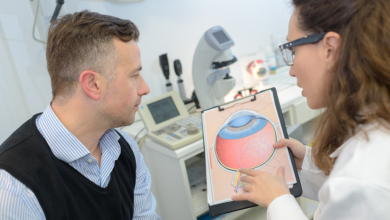Top 7 Retinitis Pigmentosa Supplements Backed by Science: Can They Save Your Sight?

Retinitis Pigmentosa (RP) is a group of inherited eye diseases that cause progressive vision loss, often leading to blindness. RP primarily affects the retina, the light-sensitive tissue at the back of the eye, and its gradual degeneration results in symptoms like night blindness, tunnel vision, and decreased peripheral vision. While there is no cure for RP, scientific advancements have led to the discovery of various Herbal Supplement for Retinitis Pigmentosa that may slow down the progression of the disease and support eye health.
What is Retinitis Pigmentosa?
Retinitis Pigmentosa (RP) is a group of rare, inherited eye disorders that cause progressive vision loss. It happens when the light-sensitive cells in the retina (called photoreceptors) slowly break down and stop working over time.
The retina is the part of the eye that detects light and sends visual signals to the brain, allowing us to see. In people with RP, the retina becomes damaged, leading to gradual vision problems.
Common Symptoms of Retinitis Pigmentosa:
- Night blindness – trouble seeing in low light or darkness (often the first symptom)
- Tunnel vision – losing peripheral (side) vision
- Difficulty adjusting from light to dark
- Blurred or distorted vision
- Eventual loss of central vision (in later stages)
What Causes It?
Retinitis Pigmentosa is genetic, meaning it’s passed down through families. It can be inherited in different ways (dominant, recessive, or X-linked), and symptoms often begin in childhood or adolescence but can vary by individual.
What Are Retinitis Pigmentosa Supplements?
Retinitis Pigmentosa supplements are vitamins, minerals, antioxidants, and herbal extracts that may help support eye health and slow the progression of Retinitis Pigmentosa (RP), a genetic eye disorder that causes gradual vision loss. These supplements are not a cure, but they are often used as part of a supportive approach to maintain retinal function and protect against further damage.
People with RP experience a slow degeneration of the retina — the part of the eye responsible for detecting light. This leads to symptoms such as night blindness, tunnel vision, and eventually, loss of central vision. Certain nutrients have been studied for their potential to delay this progression.
Common Ingredients in Retinitis Pigmentosa Supplements:
- Vitamin A – Helps maintain photoreceptor function in the retina.
- Omega-3 Fatty Acids – Reduces inflammation and supports retinal cell health.
- Lutein and Zeaxanthin – Protect the eyes from oxidative stress and harmful blue light.
- Coenzyme Q10 (CoQ10) – Supports energy production in retinal cells.
- Zinc – Aids in cell repair and boosts antioxidant activity.
- Alpha-Lipoic Acid (ALA) – Regenerates other antioxidants and supports nerve function.
- Bilberry Extract – Rich in antioxidants that may improve night vision.
Top 7 Retinitis Pigmentosa Supplements Backed by Science
If you or a loved one is affected by Retinitis Pigmentosa (RP), you may be looking for ways to protect your vision. While there’s no cure yet, certain supplements have shown promise in slowing down the disease’s progression. Below are seven scientifically supported Retinitis Pigmentosa supplements that can help support eye health and protect your vision.
1. Vitamin A
Vitamin A is one of the most researched nutrients in relation to Retinitis Pigmentosa, and several studies suggest that it may help slow the progression of the disease. Vitamin A is vital for the proper function of the retina, and deficiencies can worsen RP symptoms. In particular, retinol (a form of Vitamin A) has been shown to have a positive effect on preserving central vision in patients with RP. However, it is essential to consult an eye specialist before starting supplementation, as high doses of Vitamin A can be toxic over time.
How it helps: Vitamin A supports retinal health by promoting photoreceptor function and cellular integrity. It may delay the progression of RP symptoms when taken in the right dosage.
2. Omega-3 Fatty Acids
Omega-3 fatty acids, found in fish oil and certain plant-based oils, are well-known for their anti-inflammatory properties and positive effects on brain and heart health. For individuals with RP, omega-3 fatty acids may protect retinal cells from degeneration due to their ability to reduce oxidative stress. Studies suggest that omega-3 supplementation can support retinal health and may help improve visual function.
How it helps: Omega-3s protect against retinal inflammation and oxidative damage, which are known contributors to the deterioration of vision in RP.
3. Lutein and Zeaxanthin
Lutein and zeaxanthin are carotenoids found in leafy green vegetables, eggs, and some fruits. These powerful antioxidants play a significant role in filtering harmful blue light and reducing oxidative stress in the eyes. Lutein and zeaxanthin have been shown to protect the retina from damage and may help preserve vision in individuals with RP.
How it helps: These antioxidants improve retinal health by protecting the eye from oxidative damage and filtering harmful light, which may slow the progression of RP.
4. Coenzyme Q10 (CoQ10)
Coenzyme Q10 is a naturally occurring antioxidant in the body that plays a crucial role in cellular energy production. CoQ10 has been shown to support mitochondrial function, which is essential for the health of retinal cells. Since RP involves the degeneration of retinal cells, CoQ10 supplementation may help by supporting cellular energy production and protecting against oxidative damage.
How it helps: CoQ10 enhances mitochondrial function, provides energy to retinal cells, and combats oxidative stress, potentially slowing down RP progression.
5. Bilberry Extract
Bilberries, rich in anthocyanins (a type of antioxidant), are thought to support eye health and vision. Some studies suggest that bilberry extract may help improve night vision and protect the retina from damage caused by oxidative stress. While more research is needed, early evidence indicates that bilberry could be beneficial for people with RP.
How it helps: Bilberry extract’s high concentration of antioxidants may protect retinal cells from oxidative stress and improve visual acuity, particularly in low-light conditions.
6. Alpha-Lipoic Acid (ALA)
Alpha-lipoic acid is a potent antioxidant that has been used to treat various conditions, including diabetes and nerve damage. In terms of RP, ALA helps reduce oxidative stress and supports cellular health by promoting the regeneration of other antioxidants. Some studies have shown that ALA supplementation may protect retinal cells and improve visual function.
How it helps: ALA combats oxidative stress, promotes cellular health, and may help protect the retina from the degeneration associated with RP.
7. Zinc
Zinc is an essential mineral that supports immune function and cellular repair. In the context of RP, zinc plays a critical role in maintaining the integrity of retinal cells. Some studies have found that zinc supplementation may slow the progression of RP and protect the retina from further damage, particularly when combined with other antioxidants like Vitamin A.
How it helps: Zinc supports retinal health by promoting cellular repair and protecting against oxidative damage, potentially slowing the progression of RP.
Can These Supplements Save Your Sight?
While Retinitis Pigmentosa supplements can help slow the progression of the disease, they are not a cure. The effectiveness of these supplements varies depending on the stage of RP, the specific type of RP, and an individual’s response to treatment. It’s essential to consult with an eye care professional before starting any supplementation, as they can help determine the right combination of supplements for your needs.
Moreover, Herbal Treatment for Retinitis Pigmentosa options, like those mentioned above, can complement traditional therapies such as gene therapy and retinal implants, which are still under investigation. Combining these approaches may offer the best hope for managing RP and preserving vision.
Conclusion
In conclusion, Retinitis Pigmentosa supplements offer promising benefits for slowing down the progression of the disease and supporting eye health. While these supplements cannot fully restore vision, they may provide crucial support to those with RP, especially when taken under the guidance of a healthcare professional. As research continues, new treatments and supplement combinations may emerge, offering hope for individuals living with this challenging condition. Always remember to talk to your doctor before starting any new supplement regimen to ensure it’s safe and appropriate for your condition.




